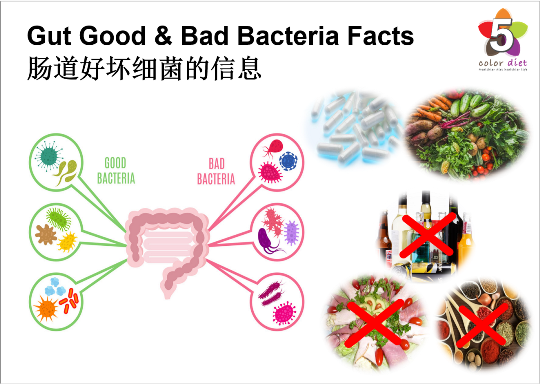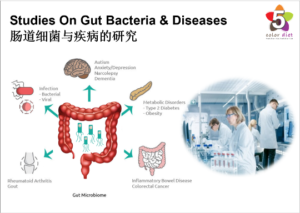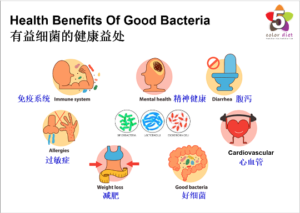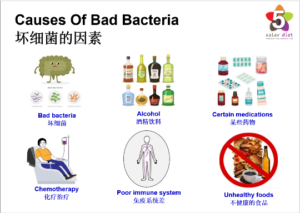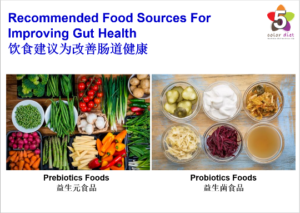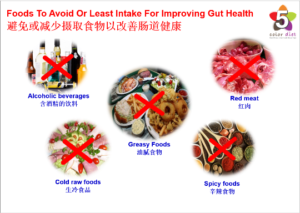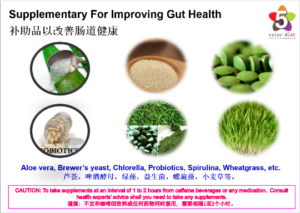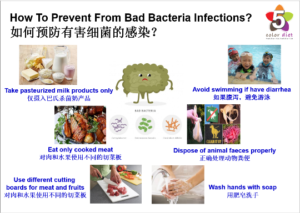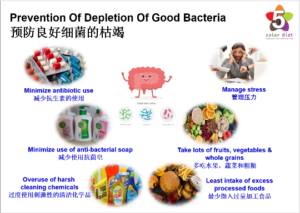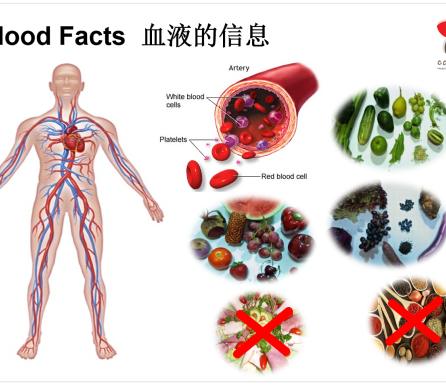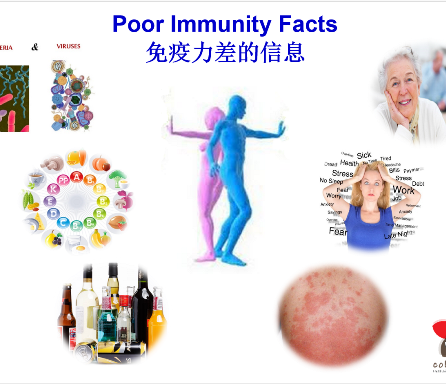
There are good & bad bacteria. Bacteria are microscopic organisms that live in air, soil, water, etc which we cannot escape from them because they are everywhere including our entire body. Bacteria can survive in the harshest conditions. The bacteria on our skin, in our airways, and in our digestive system are the first line of defense against foreign “invaders” (pathogens) that can cause infections and other health problems. At birth, there are no bacteria present in our gut. During birth, however, bacteria from the mother’s colon and vagina are swallowed by the baby and within a few weeks or months, they populate the baby’s gut.
Every person’s gut flora (Also known as Microbiome) is unique, but most of us have at least 700 species of bacteria living in our intestines at any one time. Around 85% of normal gut flora is made up of beneficial bacteria, which perform useful actions like synthesizing vitamins or breaking down our food to release energy, etc.
The other 15%, however, is made up of potentially unfavourable pathogenic bacteria which can undermine health if they get out of hand. “Bad” bacteria are traditionally defined as pathogenic bacteria, which means they may cause infection, make us sick or, in some cases, even kill us! Bad bacteria come from external influences such as food, environmental toxins and even the effects of stress on our bodies. Sometimes a disturbance in the the force, or an imbalance in the homeostasis of our bodies, will turn a healthy gut microbe into a colony of very unfriendly bacteria inside our bodies. When our body is stressed, it creates an environment in which the bacteria that were once good or “dormant,” can multiply and wreak havoc in our system. Too many antibiotics, antibacterial soap, food that is not prepared properly, excess sugar, stress and lack of sleep are some things that can cause an imbalanced body.
When this 85:15 ratio is maintained, we call that a state of Eubiosis. When the unfavourable bacteria increase in number, this can cause Dysbiosis, which can have unpleasant effects on health. The shifting balance of gut bacteria can have a major impact on our immune system health, as well as affecting hormone balance, inflammation, and even cognitive function.
The bacteria live throughout your body, but the ones in your gut may have the biggest impact on your well-being. They line your entire digestive system. Most live in your intestines and colon. They affect everything from your metabolism to your mood to your immune system. Bacteria also act as “tuning forks” for our body’s immune system, making sure it is pitched just right. The immune system should not be too sensitive or too sluggish, it needs to respond quickly to an infection but it should not over-react. If it does over-react and attacks the body itself, the result is an autoimmune disease, such as rheumatoid arthritis, lupus, or multiple sclerosis.
When we are healthy, our digestive system contains over more than 100 trillion good bacteria (weight about 1 kilogram) & 10 times more than the number of cells in our body. Research suggests the gut bacteria in healthy people are different from those with certain diseases. People who are sick may have too little or too much of a certain type. Or they may lack a wide variety of bacteria. It is thought some kinds may protect against ailments, while others may raise the risk.
Studies Reference
Scientists have begun to draw links between the following diseases and the bacteria in your gut:
● Diabetes Type 2, Obesity & Heart Disease: Your gut bacteria affect your body’s metabolism. They determine things like how many calories you get from food and what kinds of nutrients you draw from it. Too much gut bacteria can make you turn fiber into fatty acids. This may cause fat deposits in your liver, which can lead to something called “ metabolic syndrome” -a condition that often leads to Diabetes Type 2, Obesity & Heart Disease.
● Inflammatory Bowel Diseases, including Crohn’s Disease & Ulcerative Colitis: People with these conditions are believed to have lower levels of certain anti-inflammatory gut bacteria. The exact connection is still unclear. But it is thought that some bacteria may make your body attack your intestines and set the stage for these diseases.
● Colon Cancer: Studies show that people with colon cancer have a different gut microbiota, including higher levels of disease-causing bacteria, than healthy people.
● Anxiety, depression and autism: The gut is packed with nerve endings that communicate with the brain. Your doctor may call this connection the “gut-brain axis.” Studies have suggested a link between gut bacteria and disorders of the central nervous system, like anxiety, depression and autism spectrum disorder.
● Arthritis: It is thought that people with rheumatoid arthritis may have greater amounts of a bacteria linked to inflammation than people without it.
A small 2013 study reported in the Journal Gastroenterology found that women who ate yogurt with a mix of probiotics, twice a day for four weeks, were calmer when exposed to images of angry and frightened faces compared with a control group. Magnetic resonance imaging (MRI) also found that the yogurt group had lower activity in the insula, the brain area that processes internal body sensations like those emanating from the gut.
Also, a study published online Nov. 10, 2016, by Frontiers in Aging Neuroscience found that Alzheimer’s patients who took milk made with four probiotic bacteria species for 12 weeks scored better on a test to measure cognitive impairment compared with those who drank regular milk.
In addition, a recent study in October 2019 by JAMA (The Journal of the American Medical Association) oncology reported that dietary fiber and yogurt consumption was associated with reduced risks of various diseases, including metabolic disorders, cardiovascular diseases, gastrointestinal & lung’s cancers and premature death.
-
Good Bacteria Species/ Strains & Its Health Benefits
Health Benefits Of Good Bacteria
● Helps to digest food and absorb nutrients.
● Helps to produce several vitamins in the intestinal tract, including Vitamin B3, Vitamin B6, Vitamin B9 (Folic Acid) & Vitamin B12.
● Helps to promote good bacteria & maintain healthy, balanced intestinal flora in our gut.
● Helps to neutralize bad bacteria in our gut.
● Helps to prevent the growth of harmful organisms in our gut.
● Helps to protect & strengthen our immune system against many harmful bacteria, viruses & fungi, etc.
● Helps to reduce antibiotic-associated digestive diarrhea and discomfort.
● Helps to restore bacteria after disturbances from illness or medications like antibiotics.
● Helps to stimulate the growth of the intestinal lining.
● Helps to stimulate phagocytes, dendritic cells, and other immune system cells to promote immune health.
● Helps to support gastrointestinal integrity and support healthy inflammatory responses.
● Helps to support the gut-brain axis and a calm, relaxed state of mind.
The 2 most researched & commonly used healthy bacteria are Lactobacillus & Bifidobacteria.
● Bifidobacteria: This species of bacteria is commonly used in foods and supplements. They are known to support the immune system, limit the growth of harmful bacteria in the intestine, help in breaking down lactose into nutrients the body can use.
● Lactobacillus: This species of bacteria produces lactase, the enzyme that breaks down lactose, or milk sugar. These bacteria also produce lactic acid. Lactic acid helps control the population of bad bacteria. It also serves as muscle fuel and increases the body’s absorption of minerals. Lactobacillus bacteria are found naturally in our mouth, small intestine & vagina.
Good bacteria from plants are beneficial for our digestive system like Lactic acid bacteria (from sugars or other carbohydrates), Photosynthetic bacteria (from hydrogen sulphide), fermenting fungi (produce alcohol, esters & anti-microbial substances eg: antibiotic: penicillin) & yeast (from sugar & mineral salts). Types of good bacteria (Probiotics species/ strains) are:
Good Bacteria (Probiotic Species & Strains) Health Benefits
Bacillus Coagulans It is found in yogurt, kimchi & sauerkraut. It used for diarrhea, including infectious types such as rotaviral diarrhea in children; traveler’s diarrhea; and diarrhea caused by antibiotics. Bacillus coagulans is also used for general digestion problems, irritable bowel syndrome (IBS), inflammatory bowel disease (IBD, Crohn’s disease, ulcerative colitis), a bowel disorder called Clostridium difficile colitis, excessive growth of “bad” bacteria in the intestine, and infection due to the ulcer-causing bacterium Helicobacter pylori. Some people use Bacillus coagulans to prevent respiratory infections and ramp up the immune system. It is also used to prevent cancer or the formation of cancer-causing agents. There is also some interest in using it as an additive to vaccines to improve their effectiveness.
Bifidobacterium Animalis It is used in yogurt for irritable bowel syndrome & chronic constipation. It also beneficial in aiding digestion, fighting food-borne bacteria and boost your immune system. Bifidobacterium Bifidum Predominantly live in the large intestine and vagina, and adhere themselves to the walls of each, thus preventing bad bacteria from colonizing. Bifidobacterium Bifidum also produces substances that lower the pH of their environment so bad bacteria cannot thrive, and enhances assimilation of minerals. Bifidobacterium Breve Unique in its ability to compete against harmful bacteria due to the large variety of molecules it can digest (including plant fibers otherwise thought non-digestible). Inhibits E. coli. Present in the intestines and the vagina (inhibits growth of Candida albicans, the primary cause of yeast infections). Decreases occurrence of gas, diarrhea and bowel irritations. Bifidobacterium Infantis Excellent for both children and adults, Bifidobacterium Infantis is one of the first colonize in the newborn’s digestive tract. Helps to impede the growth of harmful bacteria. Excellent producer of B vitamins. Offers good results with Irritable Bowel Syndrome (bloating, gas, diarrhea, constipation, urgency and abdominal discomfort), Inflammatory Bowel Disease, ulcerative colitis and traveller’s diarrhea. Bifidobacterium Longum The most significant and important probiotics in the body, and among the first to colonize in the sterile GI tract of a newborn infant (also found in human breast milk). Stimulates the immune response and promotes microbial balance by crowding out bad bacteria that cause discomfort and neutralizing everyday toxins in the gut. Aids production and absorption of B vitamins, blocks harmful invaders, boosts the immune system and helps maintain regularity. Helps break down carbs without producing excess gas. May help to prevent or minimize various allergies or allergic reactions, inflammation associated with Crohn’s disease, or colitis. May have positive impact on cholesterol levels. Lowers the pH of the intestine/vagina to inhibit the growth of harmful bacteria.
Recent studies have also shown this strain to be beneficial in supporting a balanced mood and healthy management of stress and anxiety.
Lactobacillus Acidophilus This is the most commonly used probiotic. It found in yogurt, kefir, fermented foods (Eg: Tempeh & miso paste). Lives in the mouth, intestines (maintains integrity of the wall of the small intestine, aiding digestion (nutrient absorption) and supporting immunity) and vagina (adheres to the walls of the vagina and urinary system where it can fight infection). Helps to synthesize vitamin K and many antimicrobial substances, giving it antibiotic properties. Lactobacillus Casei It is found in raw cow milk & colostrum and used in the making of yogurt & cheese. Helps control diarrhea, has potential anti-inflammatory effects on the Gastrointestinal tract and aids in relieving antibiotic-associated diarrhea. Produces lactic acid to lower the pH of the gut, impeding the growth of harmful bacteria. Lives留 in the mouth and intestines of both infants and adults. Lactobacillus Helveticus Exerts antimicrobial activities against pathogens, helps reduce symptoms of lactose intolerance by breaking down lactose, helps to prevent and reduce diarrhea, may have implications on lowering cholesterol and blood pressure as well as help with calcium absorption. Recent studies have also shown this strain to be beneficial in supporting a balanced mood and healthy management of stress and anxiety. Lives in the intestines. Lactobacillus Plantarum It is commonly found in milk products, meat and fermented foods including sauerkraut, pickles, kimchi, miso paste, tempeh, etc. Reduces pain, bloating and improves constipation in Irritable Bowel Syndrome. Helps with antibiotic-associated diarrhea. Lactococcus Lactis It is used in manufacture of cheese & buttermilk. It has been shown to be particularly effective in delivering antigens that stimulate mucosal immunity to pathogens of the respiratory tract. It also appears to exhibit protection against non-respiratory pathogens, such as Human immunodeficiency virus (HIV), Human papilloma virus and the malarial parasite. Lactobacillus Rhamnosus GG One of the most effective strains for combating antibiotic-associated diarrhea and traveller’s diarrhea. Lives in the intestines, and fights infections both in the gut & urinary tract. Assists in dairy digestion and lactose intolerance. It is used in the fermentation of milk (Yogurt), millet & juices. Lactobacillus Reuteri Provides strong protection against infection, mental disorders (Eg: Depression, anxiety) and helps maintain a healthy immune system. Treats and prevents diarrhea. Helps relieve colic. Releases a substance capable of killing bacteria, yeast and fungi, making it popular for vaginal infection support against candida yeast infections & urinary tract infections. It is used in manufacture of cheese & fermented foods including sauerkraut, pickles, kimchi, miso paste, tempeh, etc. Saccharomyces Boulardii It is found in skins of lychees & mangosteens. A probiotic yeast resistant to stomach acids and antibiotics. Effective against reducing acute diarrhea in children and adults. Protects against both antibiotic and travellers’ induced diarrhea. Promotes immune and digestive health. Streptococcus Thermophilus One of the most useful strains in the commercial food industry. True starter strain for making yogurt (used in making cheeses too). Ferments milk sugar (lactose) that turns into lactic acid, which is effective at preventing lactose intolerance and also lowers the pH of the yogurt preventing the growth of harmful bacteria causing food poisoning. Keeps microflora of intestines balanced. May have benefits for chemotherapy patients. Dosage of Probiotics
● For children below 1 year old: take 500 million to 1 billion daily.
● For children 1 to 12 years old: take up to 5 billion daily.
● For adults: take up to 10 billion & above daily.
It is advisable to take the right dosage according to your condition because excessive consumption of Probiotics may can overstimulate the immune system and cause metabolism problems. You can check your body bacteria count using Urine bacteria test strips which High indican will show overgrowth of pathogenic bacteria & toxins. High D-arabinitol/L-arabinitol ratio shows overgrowth in small intestine. High D-lactate or D-lactic acid shows acidic body.
One study emphasized that taking probiotics with specific foods may optimize their effects. The survival rates of the microorganisms in probiotics improved when the supplement was taken alongside oatmeal or low-fat milk, compared with when it was taken with only water or apple juice. This research suggests that a small amount of fat may improve bacterial survival in your digestive tract. Lactobacillus probiotics might also survive better alongside sugar or carbs, as they rely upon glucose when in an acidic environment.
Furthermore, Lactobacillus, Bifidobacterium, and Enterococci are more resistant to stomach acid than other types of bacteria. In fact, most strains of Lactobacillus come from the human intestinal tract, so they are inherently resistant to stomach acid. Research shows that 100 million to 1 billion probiotic microorganisms must reach your intestine for you to experience health benefits. Given that probiotic cells can die throughout their shelf life, make sure you purchase a reputable product that guarantees at least 1 billion live cultures, often listed as colony-forming units (CFUs) on its label.
-
Causes & Symptoms of Bad Bacteria
Causes of Bad Bacteria
● Bad bacteria, Bacillus Cereus: This bacteria is not as well-known as salmonella and campylobacter, which can in fact dominate both of these bacteria. For this reason, some strains actually are included in probiotic animal feed to reduce the number of salmonella bacteria in their digestive system and boost growth. There are two strains of the Bacillus Cereus bacteria which can be harmful for humans. The vomiting version strikes within a few hours (1 to 5), whereas the diarrhoeal version’s symptoms tend to appear between 6 to 15 hours after consumption. On the whole, this type of food poisoning is milder and short-lived. Commonly, this particular bacteria is found in foods in contact with soil (eg: cereals) as well as of vegetable origin. Rabbits, pigs, fowl, fish, unpasteurized milk, cheese, desserts, cooked rice, pasta and potatoes are also all possible sources of contamination.
● Bad bacteria, Campylobacter: This bacteria can be transmitted to humans through the consumption and processing of raw or undercooked meat (especially chicken, turkey and fowl), unpasteurized milk, untreated water and occasionally mushrooms and shellfish. Once infected with the bacteria, it can take 3 to 5 days before symptoms become evident and it can lead to diarrhoea, fever and vomiting that lasts several days. It can in fact leave more lasting health issues such as irritable bowel syndrome (IBS), reactive arthritis and Guillain-Barré syndrome, which is a very rare but serious condition of the nervous system. At its worst, it can kill.
● Bad bacteria, Clostridium Botulinum: This bacteria is a much rarer but also much more severe strand of the Clostridium bacteria which can contaminate and grow on food. Although more common in the home than in the commercial kitchen, there have been outbreaks in the past. The most common source of this bacteria is processed canned meat and vegetables, meat and fish. Although rare, it is important to be aware of this bacteria. Once humans are infected with this bacteria, it can produce nerve affecting toxins that can impact vision, cause paralysis and even be fatal.
● Bad bacteria, Clostridium Perfringens: Clostridium is commonly found in soil and in the intestinal tract of animals and humans. Uncooked meats, gravy, cured or pre-cooked foods can be contaminated with the bacteria, whose spores are harder to get rid of with high temperatures than the bacteria itself. The bacteria prefer to grow in conditions with little or no oxygen. Once passed on the bacteria produce a toxin in the gut which can within 8 to 24 hours result in symptoms including nausea, pain and diarrhoea. It rarely causes vomiting or fever. The majority of outbreaks are associated with undercooked meats.
● Bad bacteria, Escherichia Coli: This bacteria resides in human and animal intestinal tracts and spreads during the slaughter of infected animals when intestines and/or its contents are mixed with the rest of the meat that is processed. In particular, this includes ground or mechanically tenderized meats (especially from cattle) but also unpasteurized milk, soft cheeses, and fruit and vegetables and unpasteurized juices that have been affected through contaminated water. Most strains of Escherichia Coli are harmless for humans but some strains, in particular Escherichia Coli 0157:H7, can be extremely harmful. Just a few cells of the bacteria are necessary to infect someone. The worst strand could cause fever, bloody diarrhoea, kidney damage and even death. Other strands of Escherichia Coli can cause inflammation of the intestines, sickness and diarrhoea between 1 to 10 days after consuming contaminated food.
● Bad bacteria, Listeria: Listeria is a bacteria that is carried by most animals and humans without harm if they are healthy. Similar to campylobacter and salmonella it is spread through the exposure of raw food or water to faecal matter and through the subsequent poor handling of contaminated food. Listeria can be rapidly destroyed by heat at 75°C during cooking, but is most commonly transferred through soft cheeses, uncooked eggs, and some types of processed meats (eg cooked or sliced meats), smoked fish, cooked shellfish, soft mould-ripened cheeses, pate and pre-prepared sandwiches. Although it is relatively uncommon to contract the bacteria, it can be extremely dangerous for pregnant women, those with weaker immune systems and the elderly. Contracting the bacteria can have varying results and can take approximately 30 days to develop. Some symptoms include fever, headaches, septicaemia, meningitis and miscarriage or damage to the foetus in pregnant women.
● Bad bacteria, Salmonella: This bacteria which lives in the intestinal tract of animals and humans, can be spread through the exposure of raw food or water to faecal matter and the subsequent poor handling of contaminated foods. Meat (chicken, turkey, and fowl in particular), eggs, milk and seafood can all be contaminated with the bacteria. Food contaminated by salmonella is not identifiable through smell or taste. Handling or consuming raw contaminated food, or processing this contaminated food in raw form with cooked foods, can pass the bacteria on. Fruit and vegetables can be contaminated too and can be a source of concern when unwashed if they have been in contact with manure in the soil or sewage in the water. Once exposed to the bacteria, it can take 12 to 72 hours to begin to experience symptoms such as diarrhoea, headaches, cramping, sickness and fever. Salmonella poisoning can be very serious, especially for vulnerable people such as the very young and the very old. In very rare cases, Typhoid fever can result from a severe Salmonella infection. At worst, this bacteria too has caused deaths.
● Bad bacteria, Shigella: This bacteria is a family of bacteria that, although less common, requires relatively fewer cells to be transferred for it to cause food poisoning. Similar to most other bacteria related to food poisoning, it is most easily transferred through food that has been in contact with faecal matter. Most associated with the bacteria are foods that require handling but no further cooking (such as salads and sandwiches) as well as unwashed vegetables. It usually takes 1 to 3 days before symptoms occur which can include cramping, fever, nausea, vomiting and diarrhoea containing blood or mucus. This usually lasts no more than a week, although bowl movements can continue to be affected for up to a month after. For those who fall in the high-risk category Reiter’s Syndrome could be contracted which results in painful eyes, swelling of the joints and pain during urination.
● Bad bacteria, Staphylococcus: This bacteria is a fast growing bacteria that can also produce toxins which can cause sickness. It is so common that about 25% of people carry it on their skin and hair and in their noses and throats. It becomes dangerous once the bacteria is passed to food and others through contact with the skin – in particular of those who have skin, nose or eye infections or breakages in the skin. This bacteria is spread in particular through uncooked and handled food, such as sandwiches, salads, puddings and pastries. Unpasteurized milk and cheese products are also common sources of contamination. The most dangerous thing about this bacteria is that it is tolerant of both salt and a wide range of temperatures, from approximately 4 to 46°C. Although the cooking process can kill the bacteria relatively easily, the toxins it releases are far more resistant to cooking. The illness is common but short-lived. Symptoms usually develop between 1 to 6 hours and can include vomiting, pain and diarrhoea.
● Bad bacteria, Vibrio parahaemolyticus: Vibrio is another type of bacteria that is less well-known when it comes to food poisoning. It can be contracted through consumption but also through contact with open wounds or through swimming in contaminated water. The most significant difference for this type of bacteria is that it is most commonly found in seafood, in particular oysters, clams and other shellfish, but also tuna, sardines, mackerel, squid and crab. It is also found in seawater contaminated by the faeces of infected sea creatures. Although this type of food poisoning is rare, for those with stronger immune systems, the symptoms usually occur 24 hours after the initial exposure to the bacteria and tend to be typical to food poisoning, explosive diarrhoea being the most noticeable symptom, and can last between 2 to 8 days. For those with weaker immune systems the symptoms can be far more severe and might include fever, septic shock and blistering skin wounds.
● Bad bacteria, Yersinia: Many domesticated and wild animals carry this bacteria in their intestines. Spread to people occurs by eating food or water contaminated by infected human or animal faeces. Contact with infected pets and domestic stock may also cause infection. Yersinia is able to multiply at temperatures in normal refrigerators, so sometimes if meat is kept without freezing, large numbers of the bacteria may be present.
● Alcohol.
● Certain medications.
● Chemotherapy.
● Poor immune system.
● Foods (excess starches, fried, processed, spicy, sugary), etc.
Symptoms of Bad Bacteria In Your Gut
● Abdominal bloatedness & pain.
● Allergies.
● Bad breath.
● Bloating worse with carbohydrates.
● Cravings for sweets, bread, chocolate & sugary foods.
● Constipation.
● Depression.
● Diarrhea.
● Edema.
● Fatigue.
● Frequent colds.
● Itchy anus.
● Itchy eyelids.
● Mucus in stools.
● Nutritional deficiencies despite taking supplements.
● Recurring fungal infections.
● Soft foul-smelling stools.
● Weight loss.
● Yeast infections (candidiasis), etc.
-
Recommended Food Sources For Improving Gut Health
● Prebiotics are dietary fibers which cannot be digested by the human body. They are food for probiotics in our gastrointestinal tract, Eg: Aloe vera, asparagus, artichokes, banana, berries, chicory root, dark chocolate, garlic, green vegetables, honey, leeks, onions, root vegetables: (Beetroots, carrot, radish, sweet potatoes, yams) & whole grains (Cereals, oats, amaranth rice, black rice, brown rice, red rice, buckwheat, millet, quinoa), etc.
● Probiotics are Live beneficial microorganisms, also known as “Good bacteria” that help keep your digestive system healthy by controlling growth of harmful bacteria, Eg: Acidophilus, aged cheese, brewer’s yeast (Bovril, marmite, vegemite), coconut water kefir, fermented foods (goat yogurt called kefir, kimchi, miso paste, pickles, sauerkraut (fermented cabbage), tempeh, yogurt, etc), sourdough bread, etc.
-
Foods To Avoid Or Least Intake For Improving Gut Health
● Alcohol, beans, cold or raw foods (Eg: iced drinks, salads or white/ tan & brown fruits & vegetables), dried fruits, dairy products (butter, cheese, eggs, milk, Except yogurt), excess starches, caffeine beverages, carbonated beverages, greasy foods, processed foods, spicy foods, meat, nightshade vegetables (chili, brinjal, potatoes & tomatoes, etc), poultry, sugar, hydrogenated oils, wheat products (biscuits, cakes, white bread), salt, etc.
● Avoid smoking & stress.
-
Supplementary For Improving Gut Problems
● Herbs: Aloe Vera, Barley grass, Brewer’s yeast, Dang Shen, Garlic, Ginseng, Micro-algae (Blue-green algae, Chlorella, Spirulina, etc) & Wheatgrass, etc.
● Amino acids, Vitamins & Minerals: L-Glutamine, Vitamin A, Vitamin B complex, Vitamin C, Vitamin D, Folic acid, Iron, Selenium & Zinc, etc. Also, Probiotics with Prebiotics.
Note:
(1) To take supplements at an interval of 1 to 2 hours from caffeine beverages or medication.
(2) Consult health experts’ advice shall you need to take any supplements, especially if you are pregnant, breastfeeding or having any medical conditions.
-
Alternative Therapies For Improving Gut Problems
● Apply footbath for Gastrointestinal System’s detox. Use natural ingredients like herbs & foods per above Recommended Food Sources For Gastrointestinal System Body Imbalances related to each pattern.
● Exercise minimum 30 minutes at 3 to 5 times weekly will help to promote blood circulation & metabolism which will contribute to a healthy immune system.
● Apply meditation 1 to 2 times daily to calm the nerves, emotional mood imbalances & reduce stress because stress can trigger digestive issues.
-
How To Prevent From Bad Bacteria Infections?
● Consume only pasteurized milk and milk products, such as soft cheese, ice cream, and yogurt.
● Cook all meat thoroughly.
● Prevent cross-contamination in the kitchen by using one cutting board for raw meat and another cutting board for fresh produce. Carefully clean all cutting boards, countertops, and utensils with soap and pour hot water over them or with pour vinegar over them after preparing raw meat.
● Wash hands thoroughly with soap and water before eating and preparing food, after contact with animals, and after handling raw meat.
● Dispose of animal faeces (poop) in a sanitary manner.
● Anyone with diarrhoea should avoid swimming in pools.
-
Prevention Of Depletion of Good Bacteria
● Minimize antibiotic use.
● Minimize use of anti-bacterial soap.
● Overuse of harsh cleaning chemical.
● Least intake of excess processed foods, sugar or starches.
● Take lots of fruits & vegetables, whole grains eg: beans, cereals, oats, nuts, seeds, brown rice, buckwheat, millet, quinoa, etc.
● Manage stress.
● Drink purified water.
● Use air-purifier with natural herbs (Ginger, peppermint, lemongrass, flowers, etc).












